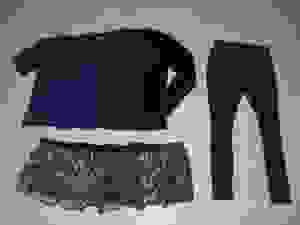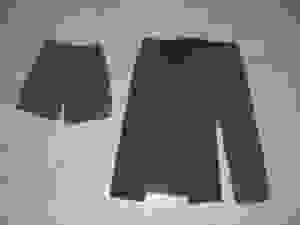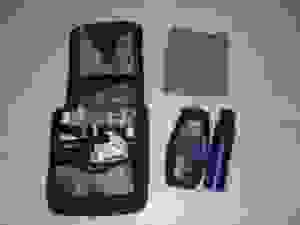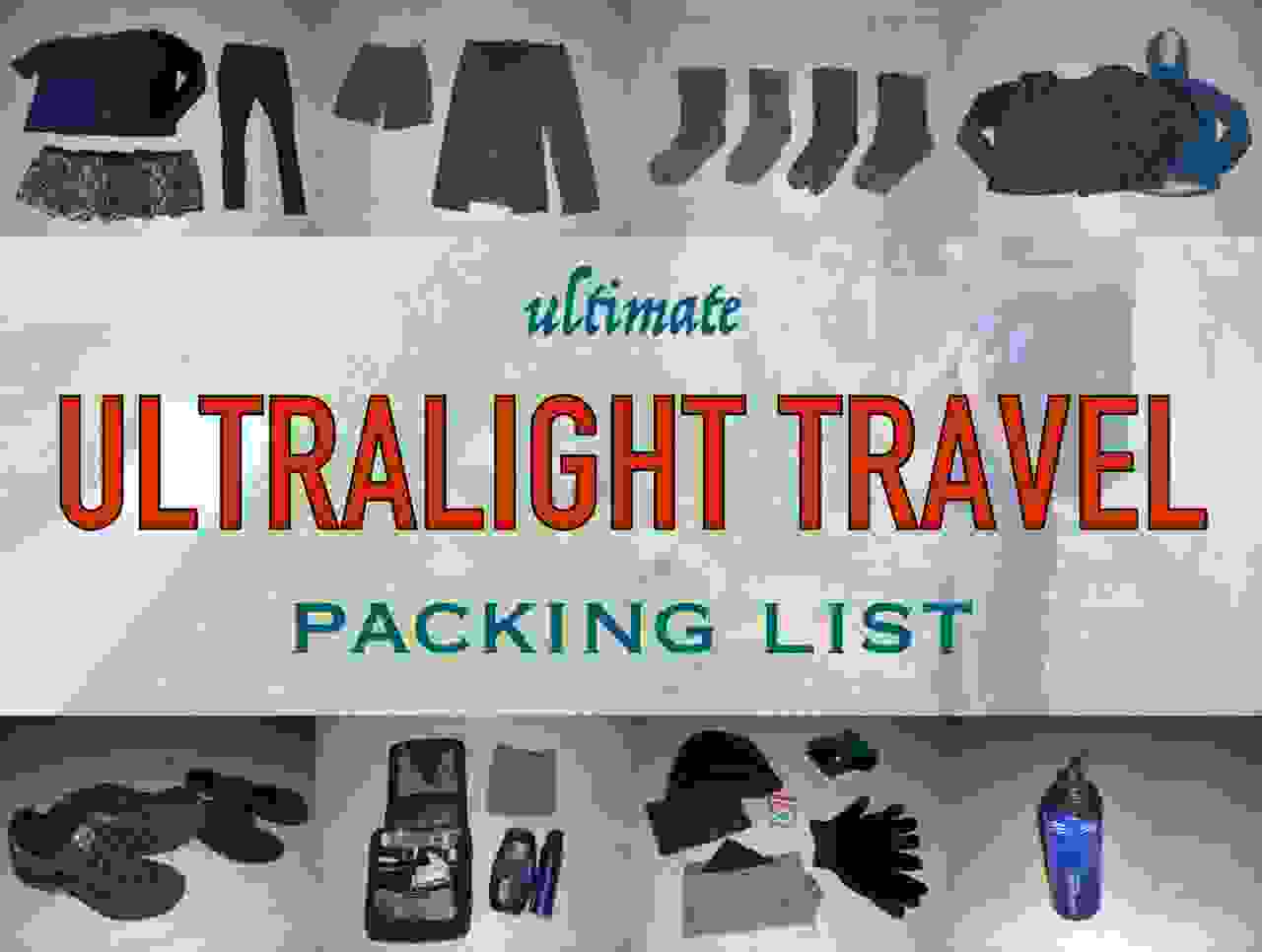Quite a few times I’ve heard backpackers complain about weight limits or maximum bag allowances on airlines. They haul 40-pound monstrosities that limit how comfortable they are, how fast they can run to catch the train, and how often they have to take a taxi because their bag is too heavy. They end up going a little slower, seeing a little less, and paying a little more. When they look at mine, they ask me where my “real” bag is.

I have traveled around the world on extended trips up to 9 months long with nothing but a 20 liter daypack, through summers, winters, jungles, cities, and everywhere else. It weighs less than fifteen pounds and fits in the overhead compartment on the plane.
I never have to worry about lost bags, check-in times, or waiting by the conveyor belt. I am the first person in line for customs, and stroll right in. I spend nothing on laundry or taxis. I am the first to finish packing every morning. I never spend more than five seconds trying to find something at the bottom of the bag. I wander around for hours with my pack, just because I can. I’ve gotten to the point that I really don’t know how to do it any other way, and my scrawny shoulders continue to thank me.
It’s a fun game I like to play with myself find to be an amusing intellectual challenge, but despite year after year of life on the road, I have met less than half a dozen people who do the same thing, and we are endlessly perplexed. Sadly, I have never been able to convince anyone to follow this plan. But I’ll give it one last try. It’s for your own good.
How to pack for ultralight travel

When thinking of things to pack for a trip, most people bring everything, “just in case,” and end up hauling a bag full of garbage they never use. Don’t do that.
Not a single person I’ve ever met has said “I wish I brought more.” You can spot the seasoned travelers simply by bag size. Instead of thinking about what to add, think about what you can cut. You know who else said that? Oh, just Bruce Lee is all.
Your limit should be the same as the airlines: 22” x 14” by 9”, or 45 liters (though it’s slightly smaller on certain no-frills European airlines). This will keep you in check (and allow you to reap the benefits of carry-on-only travel), since it’s all you can take, and it’s more than you need. If I got by with 20, you’ll get by with 45. Trust me. Just peruse this page and assume you’ll include twice as much.
1) Shopping for Ultralight Backpacks
For quite some time, the only options available were hiking packs, and while they’re quite good at what they do, a few companies have started designing what I consider travel-worthy backpacks (carry-on size, with a fully opening zippered panel, so you can pack it like a suitcase), which work great when you want to open everything up, instead of traditional top-loaders that need to be emptied completely to find something down at the bottom.
Since travel often requires lots of packing and unpacking, and somewhat less walking, it generally makes more sense to get a backpack optimized for travel, rather than hiking (unless you plan on hiking with it, of course). Check out a list of favorites here.
Wheeled suitcases aren’t a terrible idea, especially if you have back problems, but just remember they add weight and you’ll go crazy on cobblestones.
2) Ultralight Travel Clothing Basics
People constantly ask “how can you have enough in a daypack to travel for a year?” The thing is, you’re not packing for a year. No one is.
The secret is to pack the same gear, no matter how long the trip is. I bring 3 sets of clothes, wash whatever outfit I’m wearing when I take a shower, and hang it up to dry overnight. And you don’t even need to do manual laundry. If you bring a week’s worth of clothing and do laundry once a week, you can travel forever. It’s that simple.
You might get stuck with a sink wash sooner or later, which is why everything should (hopefully) be high-performance and versatile, wicking sweat and drying quickly, which cools you in summer, and warms you in winter. Try not to bring separate clothes for hiking, lounging, and clubbing. Just get clothes that look good and feel good. They should be suitable for any social situation. It’s a tall order, but it can be done.

Shirts: No cotton. It soaks up sweat and stays wet all day. Get polyester or merino wool t-shirts (read more about why merino is everyone’s favorite here), both of which wick sweat and dry quickly. Polyester should have an odor-control treatment if you plan on making any friends. Though I won’t judge you, it’s nice to have a fancy shirt for special occasions. I’d skip warmer thermal underwear. You can only wear them in winter, and you’ll probably bring t-shirts anyway, which dry faster after a sink wash. Leave the insulation to the outer layers, which you don’t need to wash as often.
Underwear: Let me tell you, “performance underwear” feels just as good as it sounds. Spoil yourself. Again, make sure it’s quick-drying, lightweight, odor-resistant, and comfy (take a look at a list of favorites here). In winter, long underwear works wonders. You’ll only need a single pair if you wear regular underwear underneath, so you won’t have to wash the heavier one as often.

Pants and shorts: Travel pants, ideally, should be lightweight, wrinkle-free, water-resistant, quick-drying, and look completely normal, despite having a few hidden pockets for hiding valuables. There are literally only a few that actually do this (which is ridiculous), but you can find a list of good travel pants here. Try to find pants that don’t look too silly, so you won’t have to bring extra pants for fancy fun times. If your pants fit, you can skip the belt, and for guys, quick-dry shorts double as swimwear. You can cut some corners here, as cotton pants won’t hold you back so much if you have an umbrella, don’t mind washing rarely, or have laundry facilities. Given the rarity of truly travel-worthy jeans, don’t feel bad bringing regular jeans.

Socks: I bought a pair of merino wool socks and threw out all my white cotton gym socks the same day. Seriously. Merino wool warms in winter, cools in summer, insulates even when damp, dries quickly, resists odor, and is soft and plush and wonderful. I’ve found nothing more comfortable for my feet. Most socks blend merino with polyester and other materials, and work well. I bring two ultralight pairs for summer use, and a warmer pair in winter, worn over the lighter ones so I don’t have to wash the heavy ones as often.
3) Outer layers
Layering is crucial. It’s better to take a few lighter pieces that you can layer together, rather than a heavy one you can only wear in Antarctica. You may have your own comfort system on this, but here’s what I recommend (or check out my winter travel gear list for details):

Inner warm layer: Find the lightest fleece or wool sweater you can find, comfortable when it’s cool, but not cold. I look for close fits to layer more easily, and a high, snug neck so I can skip the scarf.
Outer warm layer: For winter travel, goose down or synthetic insulation jackets (those big puffy ones) are one of the best ways you can shrink things down. Goose down is triple the warmth of fleece for the same weight, and packs down to half the size, meaning a medium-warmth jacket weighs 8 ounces. Synthetic insulation isn’t as warm or packable, but it dries faster and retains its insulating qualities when wet, whereas goose down does not, which is why I have thus far gone with synthetic. Since it is encased in a nylon shell, it works well as a windproof outer layer, while the fleece sweater on the inside will be comfortable against your skin.
Rain jackets: I don’t have much to say here, and umbrellas work well enough anyway. I just look for light weight, comfort, a hood that covers my face, and enough venting to keep me cool (take a look at some ultralight rain shells, some of which are half the weight of standard jackets). Don’t get something insulated that you can only wear in winter. Layer instead.
Wind jackets: Climbing up a windy mountain on a chilly day calls for something windproof that won’t overheat, and a wind shell is the only thing that fits the bill. I wouldn’t call it a necessity, but mine is about 3 ounces, and I wear it all the time.
4) Travel Shoes
I met a guy with separate hiking boots, running shoes, evening shoes, and sandals. Here’s an idea. Why not buy shoes that look good and feel good?

There’s not much reason to bring serious hiking boots, which are designed to support 50-pound packs, which you won’t have. A nice-looking, tough, comfortable shoe that fits properly and offers good support will be suitable for all occasions. Especially if they’re waterproof.
One pair of shoes, end of story (probably leather, described here). And one pair of flip-flops or sandals. Comfy but light.
Women’s fashion is less forgiving. If you have to bring a separate pair of evening shoes, just make them small. If all it’s got on top are straps that can lay flat, perfect. Only bring one pair. Anyone who calls you out on repeat clothing will be another scruffy backpacker who will be in no place to make comments.
5) Travel Accessories
Again, anything you stuff in here should add value, not just weight. So far I’ve avoided packing cubes, but they’re not a bad idea.

Toiletries: I travel with nothing but airplane-sized bottles (maximum 3.3 ounces, or 100 mL) so I can take them on the plane, and reuse them on each trip. When the bottles run out I buy a larger one, refilling the mini so I can throw the big one away sooner. This way I might have one or two big bottles at any one time, instead of my entire supply being oversized (though an all-in-one bar soap is great for solving this problem). Check out a comprehensive toiletries list for details.
Travel towel: This is another of the most significant ways you can cut size and weight, as huge cotton towels are big, heavy and dry slowly. Microfiber towels are light, small, super absorbent, and wring out 90% dry. You can even get by with a washcloth-sized micro towel which will fold up to the size of a napkin, though it’ll take some extra time to dry yourself off. Definitely get one of these. They’re cheap and enormously efficient (though I’ve recently discovered linen towels are even better).

Sleeping bags: This is another one of those “surely I must need this” items that people end up never using. 99% of people stay in hostels and never use their sleeping bag. If you’re worried about hostels that require you to rent sheets, I’ve traveled for 15 months and spent maybe $3 on them. It’s not worth the extra weight. If you want to be a little warmer, you can sleep in your long underwear, or you can get a bag liner, which is incredibly lightweight and small, and will keep you warm enough indoors. If you really need a sleeping bag, you can find some that are the size of a 1 liter water bottle and weigh 1 pound. But if you don’t plan on camping, forget it.
Daypack: I try to avoid bringing an extra bag, but now that we have ultralight options that fold up into their own pocket, I’d recommend it. You’ll do a daytrip or climb a mountain and you’ll want to bring a jacket, food, water, maps and whatever. I had one made by Sea to Summit that holds 20 liters, weighs 2.4 ounces, and fits inside a coffee mug.

Other extras: I’d recommend a money belt (unless your pants have security pockets), a deck of cards, a nice small camera (or smartphone), a journal, sunglasses, an outlet converter, hat, gloves, and two books (it’s hard to find a book right away once you finish), or an e-reader. Those are all the extras I ever use. Umbrellas aren’t a bad idea if you don’t want to spend $100 on a rain jacket. Just remember that if you want to add extras, think about how often you’ll use it, and if it’ll be worth it.
Budgeting for ultralight travel

Poor? So was I. Patrol eBay and watch for sales. Besides, you shouldn’t buy more than a minimum of gear. Three backpacking outfits shouldn’t be too expensive, and you might have a few running shirts already, and some warm clothes, and good shoes. Some of it you’ll wear back at home after the trip, especially the socks and underwear.
If you have to cut corners when packing for a trip, regular cotton pants and shorts will be fine, as long as you’re not washing too often and rainstorms don’t ruin your day. You can skip the rain jacket and bring an umbrella, and winter gear can be cut outside of winter. I wouldn’t cut the travel towel, since it’s less than $20 and will save you lots of space and weight, and quick-drying base layers are kind of a necessity for this to work, unless you’re doing machine washes once a week or so, in which case it’ll be fine.

You should now be a thoroughly converted ultralight, minimalist backpacking genius. Once you do this, it’s hard to go back. This method is forced upon all travelers on Rick Steves’ tours, many of whom claim it’s impossible ahead of time, but talk about how great it is after. This strategy has close to a 100% success rate. And whether you’re packing for Europe, or Asia, or India, summer or winter, it’s always the same.
Oh, and by the way, the photos displayed here represent absolutely everything I took on a 9 month trip (except the camera), from temperatures below freezing to body-temperature sunshine. Towards the end of the trip, someone asked if there was anything I would have added. I said no. Someone else asked if there was anything I would have removed. I said no. I was super proud of myself.
Eventually I added a few things: A packable daypack, an ultralight wind jacket, a collared shirt, and swapped the emergency blanket for a sleeping bag liner instead (which is still just optional anyway). Overall weight was almost the same, and these items can be extremely useful.
Hmm. Talking about all this makes me want to go shopping. I’ve been working on getting my year-round pack down to about 12 pounds…





I’ve traveled with a 46L and a 13L daypack, strongly considering one pack to consolidate.
With your 20L do you bring that bag on your daily adventures on an international trip? Even if merely emptying out the clothes and Toiletries for around town.
I think I can fit all I bring in a 30L, but bought a bigger bag 38L that I won’t pack fully but since I won’t being my 13L daypack I’d need to bring this around for day to day and am concerned with the size despite being very compressible it’s still very tall.
Some people empty out the regular bag and use it as a daypack, but usually I’m a little too paranoid about losing the bag to do that, so I generally bring a smaller, packable one. On that particular trip I didn’t bother bringing a daypack at all, and just used pant pockets for small things, and tried to figure out what sort of jacket I might need on which day and hope for the best. But I think bringing a daypack is a better idea.
The Golden Rule Of Traveling Light: You will use exactly the things you use at home everyday when you travel: A standard toilet kit. Any Medicines. A simple Laundry kit. A Phone and charger. The underwear and socks you wear and that spare set to rotate through hand wash. One and only one pair of pants and shoes. A short sleeve under shirt, synthetic, that you wash everyday. A long sleeve under shirt that doubles as a sweater and night shirt. I like long underwear “tights”. They are sleep wear and extra warmth. A long sleeve dress shirt that is also a light jacket. A fold up ball cap. I don’t like white synthetics as they yellow.
Lately I have been experimenting with a fishing/hunting vest. It is possible to use those pockets for a lot of small items and medicine bottles. Here is a little more warmth in cooler months. I can’t go bagless. I have found that a messenger bag comes in handy on the street!
Maintain the site! Just so many good ideas and product reviews! Thanks!
Eight US pounds. One bag. Freedom and simplicity. If you want to be a clothes horse you will work like a horse carrying clothes!
OK THIS SAVED MY LIFE. Usually I tend to overpack, but I was googling around for what to pack for my first trip to Europe (1 month solo) and I was inspired by this post to bring only my college backpack (25L Dakine Mission – the hip strap was really nice) and a small camera bag. Everyone I met in hostels thought I was crazy at first, but then they were jealous of my freedom. Not once did I have to drag a suitcase the size of my body onto a train or break my back wearing a huge hiking backpack and a smaller backpack on the front like so many other travelers I saw, and I had everything I needed. The freedom was amazing. Also thank you for the introduction to 100% linen towels!! I’ve been telling everyone how game-changing they are. I’ll try to pack even lighter next time when I can afford performance clothes. Thank you!
DAY SEIZED
If you elect to go with just one worn set of clothes select “tactical” and military spec clothes! Your seams can NOT fail! I like Tru-Spec 24-7 Eclipse pants because they don’t have big baggy leg pockets. Just some discrete leg pockets that hug close. They are cotton-poly ripstop or 100% Nylon and double and triple sewn. Kinda Winter and Summer weight! One pair of pants. Better yet wear good old Jeans! Period. A nice 5-11, Tru-Spec or Duluth Trading ripstop shirt in a general purpose color. Two pairs of socks and underwear in rotation through hand laundry. I used Hotel and Cruise Boat bar soap the whole time! A short and long sleeve undershirt. One pair of comfy shoes or five inch boots. See my post above! This takes a little courage the first time but you won’t be sorry!
I just did a week through the Pacific Nortwest and San Francisco with this kit. About eight pounds. No problems. No hitches or glitches. Easy!
I like your list a lot because it has the potential for a fully functional outfit that still looks nice enough for casual social events (especially those merino wool button up shirts I saw elsewhere on your blog). However, the one thing that might be lacking here is a choice of stylish jacket. All your jacket/warmth layers are incredibly practical, but none of them are really suited for a nicer evening out. What would you recommend for a situations like this? Have you found stylish yet packable jackets that work well with your minimalist style?
Very few companies do fancy outerwear, but check out Nau, Outlier, Mission Workshop, Prana, and Anywhere Apparel for now. Some of the Uniqlo items work fairly well, with their lack of logos and general subtlety.
To add in a dressier jacket, what layer would you give up to stay lightweight? Would it replace the fleece?
Also, how well does a good microfleece jacket pack down? I’ve always found them pretty bulky, but maybe I just have poofy or low-quality ones.
Lately, I’ve been bringing a single, decent-looking, medium-warmth jacket along with a long sleeve shirt (don’t have down yet) and shell. It works pretty well, though usually dressier jackets don’t pack down very small. How do you get around this? Are there nice looking jackets that actually pack down well, or do you just sacrifice style/keep it outside the pack when traveling?
A couple companies have started making some really nice-looking rain jackets that aren’t all shiny and outdoorsy. Ministry, QOR, and even Uniqlo have some classy options at the moment. If you can find one you like, obviously that’ll replace the waterproof jacket. If you want to bring a nice-looking, non-waterproof jacket, I think it should replace the down jacket (unless you’re going somewhere super cold), since you should still have something like a light sweater underneath, especially for when you’re indoors and don’t want to wear a real jacket. And yes, fleece is a little on the bulky side, because it’s designed with those hairs that stick out. A wool sweater will be a little more space-efficient for the same level of warmth.
I bought a Uniqlo Down Sweater! This thing is amazing! Super lightweight. Squishes down to about fist size. Very warm!
I’m planning a New England Cruise next Spring from NYC. The weather will be cool maybe even cold. Aside from my minimal kit I think I will take a simple sports coat. They look good. They are relatively cheap. A gray jacket works with black pants and a light blue shirt! It had better because that’s all I wear!
Due to my age [70] I drag my little bag straped to a dolly now. A 20 Liter Dry Bag. About 15 US Pounds counting the dolly.
I will never compromise on my basic minimalist kit!
Thanks for the soap box!
Check out Bluffworks’ new blazer. The Kickstarter just ended, but if you want a blazer that’ll never wrinkle and will handle whatever you throw at it, I think that’s as good as it gets. I got a free sample so I’ll be talking more about it soon, but I have nothing but great things to say.
I had a look at the Bluffworks Blazer. They look pretty good. Comes in a couple of dark colors. $295. I wonder if they’ll have a 50R?
I just got a Red Cap light blue long sleeve “work shirt”. It’s 60/40 Polycotton. An XXL fits great! It’s from Amazon. I am going to test it hard. Handwash.
Machine wash. Hang dry. Under backpack straps! I may have a local seamstress add stiching on the shoulders for more strength. When you have one shirt with you it has to be mil-spec! It has to work.
I got some Exofficio “travel” underwear that I’m going to test. They get good five star reviews on Amazon.
Here is an idea: check out the Demi Hugger! It’s a long soft and wide strap that secures your pack to a wheeler. Velcro. It seems to work good too!
Here’s something I am experimenting with : A clothing roll or hobo roll. I lay out my favorite Tru-Spec Eclipse pants then add a long sleeve under/sweater/sleep shirt [a three fer!] , a pair of underwear and socks, tights and a nylon pullover all folded so that when I roll them into a tight bundle I can secure it with one inch double D-Ring straps. I add a short “handle” to carry it.
I add flat items and toiletries, cables, laundry sheets and anything else that will fit. Rolled tight and secured it makes a duffle bag! Just no bag present. All of it is useful/multi-use stuff. Also there is NO 311 baggie!
The rest of my medicines and other small stuff goes in a sling bag I bought in Cozumel, Mexico. That’s my “personal item”.
I put EDC, Passport and a few medicine bottles in pockets and belt pouches.
It’s a ridiculously small amount of baggage! And it seems to work! The rest of my clothes I wear. That’s my Standard Travel Ensemble. I add a grey sports jacket. I can function in a wide range of temperatures and social settings.
The feeling I get boarding a plane, ship or Taxi is one of freedom! My baggage is manageable. I am not a pack mule! I go have fun and see new things and have the energy to do it!
I know this won’t work for everyone. Feel free to tweak, add, subtract or ignore. Also this takes courage. Leaving for a trip with just this “luggage” is scary. But you can do it!
Check out the “ranger roll” or “military roll” method for packing t-shirts, socks and so on. Works pretty well. You can roll the socks and underwear inside the t-shirts, so they’re all in one little package. Certain pants are bulky enough that folding seems to work better than rolling, but it depends on the fabric and so on.
I just have to clarify something. I made a recommendation for Tru-Spec pants.
It seems the pants aren’t tru-spec after all. They have a severve sizing problem! Waist sizes are all over the place. You order a 42 hoping to get a 40 and they provide what is obviously a 38!
Shop for pants that are accurately sized.
Thanks for this great list! I like your site and have used it as a resource for multiple travel-related issues. You and I have the same mindset in terms of lightweight packing – over the years of my backpacking, my travel gear has grown smaller and smaller until I recently decided to cut it all down into a “school-size” backpack that could blend in on a bus, train or around town in any city around the world and picked up a 25L REI pack that I intend to take to Asia. (I originally was going to use a very versatile 15L Osprey pack, but in the end I got a good deal on the 25L and decided not to go so extreme. Maybe for my next trip!)
I’ve been relatively light-minded for the past couple years, but seeing as this is my first time to go so small, I was relieved to find somebody online that was doing the same thing (and had a packing guide to boot)! I already have a lot of the things you mention, but I’ve been looking more into filling out my travel wardrobe with synthetic and merino wool clothing, and there are certainly a few other great tips & tricks you provided that I hadn’t thought of (such as linen towels). It’s nice to pad out my experience with that of someone who’s already been-there-done-that and has tried and tested the equipment I’m looking into.
Keep up the good work!
No problem. I certainly enjoy knowing I’m getting people to make fewer mistakes than I did. Ultralight travel isn’t for everyone, but I think getting even halfway there is pretty great. It’s interesting to see just how minimal people can get, although I’m a little too paranoid about bringing just TWO changes of clothes, since it would be a disaster if one outfit got ruined, and you literally had no option but the main one, so I say three is a good minimum.